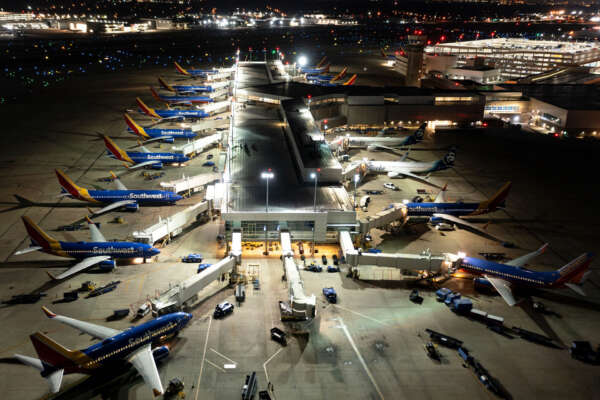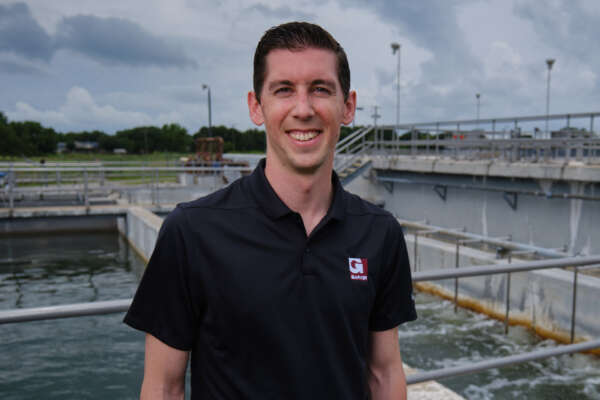Soaring down the runway, the F-16 Fighting Falcon dropped its tailhook and snagged the arresting cable that spanned the pavement. With a whirl and a snap, the steel wire and nylon tape unreeled and stretched like a taut rubber band, bringing the fighter jet to a controlled stop after its emergency landing.
As one of the final steps in replacing and relocating two aircraft arresting systems on Tulsa International Airport's joint-use Runway 8/26, a pilot with the Oklahoma Air National Guard's 138th Fighter Wing tested the new system by simulating a malfunctioning aircraft on approach. Senior Master Sergeant Eric Jansson, who oversees power production and barrier maintenance for the Oklahoma Air National Guard, had instructed the F-16 pilot to engage the arresting cable at 120 knots (138 mph).
"The pilot landed dead center on the runway, and the aircraft arresting system successfully absorbed the jet's momentum each time it was engaged," Jansson said. "The testing went off without a hitch, and the new systems are working great."
Runway 8/26's aircraft arresting systems, known as BAK 12/14s, had been in operation for more than 30 years; however, they required relocation because they didn't meet the latest U.S. Air Force siting criteria.
"The arresting system was too close to the runway threshold and had to be reconstructed 1,500 feet from the runway's ends," said Garver engineer Jeremy Stahle, PE. "This meant moving them another 500 feet toward the runway's middle. Also, the pits that house the braking system were updated and relocated outside the runway safety area, 250 feet from runway centerline. This allows crews to perform maintenance inside the vaults without having to close the runway."
After the aircraft arresting systems on the runway's approach and departure ends were demolished, construction crews installed new equipment at the correct airfield locations. This included energy absorbers with 66-inch multi-disc rotary friction brakes and arresting engines (BAK-12), a hook cable support system (BAK-14) and redesigned underground concrete vaults. The vaults shelter the energy absorbers, electrical components, and compressed air and control systems. Garver also conducted extensive research and coordination to modify the electrical and power services to the arresting systems.
The aircraft arresting system utilizes a retractable cable support system that gives air traffic controllers the ability to raise and lower the 1 1/4-inch diameter cable below the pavement as needed. Construction crews removed a cross section of the runway and cast a concrete trough to house the BAK-14 hook cable support system. The cable system has a runout of 1,200 feet and can stop a jet traveling up to 180 knots (207 mph).
Construction crews also used a diamond grinder to remove surface irregularities on the existing runway, 200 feet east and west of the cable. The maximum allowable pavement surface profile deviation around the aircraft arresting systems is 1/8 inch to ensure that an F-16's tailhook will catch the cable and not skip over it.
Relocating the aircraft arresting systems on Runway 8/26 was only a part of the project scope. Garver also designed runway repairs to prepare the pavement for all traffic operations when Runway 18L/36R is closed for reconstruction. Garver provided engineering services for 600 square yards of concrete pavement rehabilitation, 5,500 square feet of spall repair, 3,200 square yards of seal coat, new runway pavement markings, and the replacement of 43 airfield guidance signs, eight mandatory hold signs and six distance remaining signs.
"When the need to upgrade the BAKs presented itself, we worked with the Base Civil Engineer's staff to develop a project that integrated the aircraft arresting system replacements into our runway projects," said Deputy Airports Director Jeff Hough with the Tulsa Airport Authority. "Garver's team not only brought the right technical expertise to the project, but their staff also did an excellent job of coordinating a myriad of details with the airport as well as local and out-of-state Guard personnel."
Runway 18L/36R is now under construction, and Garver is providing similar design services to relocate the BAK 12/14s on the main runway. "We've designed both the north and south arresting systems, and they will be constructed under a very compressed time schedule," said Garver Project Leader Kelly Fincannon, PE. "We'll also provide 24/7 construction observation to complete the project on time."









Share this article